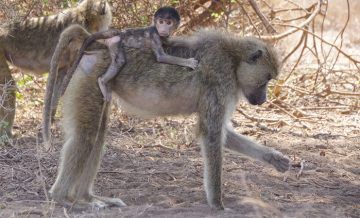Helen Santoro in Science:
 You are what you eat. And when you eat a lot of dirt, the makeup of your gut will change—at least, if you’re a baboon. A new study shows local soils, not genetics, may be the primary determinant of baboons’ gut microbiota, the vast ecosystem of microorganisms that live in the gut, digesting food, fighting infections, and breaking down toxins. Past research has shown that the gut microbiota of baboons varies across different populations. Scientists wanted to know the cause: Is it the genes they share with other relatives, the distance between populations, or the environment that creates these internal changes? To find out, the researchers gathered poop from 14 different baboon populations in Kenya’s primate hybrid zone—an area where yellow baboons (Papio cynocephalus) and anubis baboons (P. anubis) mingle and interbreed (above). Along with analyzing the baboons’ DNA, researchers looked at 13 different characteristics of the environment where the stool was collected, including vegetation, elevation, climate, and soil.
You are what you eat. And when you eat a lot of dirt, the makeup of your gut will change—at least, if you’re a baboon. A new study shows local soils, not genetics, may be the primary determinant of baboons’ gut microbiota, the vast ecosystem of microorganisms that live in the gut, digesting food, fighting infections, and breaking down toxins. Past research has shown that the gut microbiota of baboons varies across different populations. Scientists wanted to know the cause: Is it the genes they share with other relatives, the distance between populations, or the environment that creates these internal changes? To find out, the researchers gathered poop from 14 different baboon populations in Kenya’s primate hybrid zone—an area where yellow baboons (Papio cynocephalus) and anubis baboons (P. anubis) mingle and interbreed (above). Along with analyzing the baboons’ DNA, researchers looked at 13 different characteristics of the environment where the stool was collected, including vegetation, elevation, climate, and soil.
The clear winner was soil. Its impact, as measured by the difference in microbiota makeup, was stronger than all other environmental factors. It was three times better at predicting differences than the physical distance between populations and 15 times better at predicting differences than genetic factors. The researchers also found that baboons living in areas with salty soil (which has a smaller selection of microbes) have less diverse gut microbiotas. The findings, published today in the Proceedings of the Royal Society B, are the first to show that the environment may have a stronger influence over baboons’ gut microbiota than their genes.
More here.
